Page 588 of 660

5888-2. Steps to take in an emergency
AVENSIS_OM_OM20C79E_(EE)
If the parking brake cannot be released
●Vehicles with Multidrive: Shift the shift lever to P.
● Vehicles with manual transmission: Shift the shift lever to 1 or R.
● Turn the engine switch to the “LOCK” position (vehicles without
smart entry & start system) or off (vehicles with smart entry & start
system).
● Check that the parking brake indicator is off.
● Chock the tires.
● Stop the vehicle on a hard, flat surface.
In the event that the battery is discharged or switch operation
does not release the parking brake, the parking brake can be
released manually using the procedure below. This procedure
should be performed only if necessary, such as in an emer-
gency.
If the switch cannot be operated even when the battery is nor-
mal, the parking brake system may be malfunctioning. Have the
vehicle inspected by any authorized Toyota retailer or Toyota
authorized repairer, or any reliable repairer immediately.
Before releasing the parking brake manually
Page 591 of 660
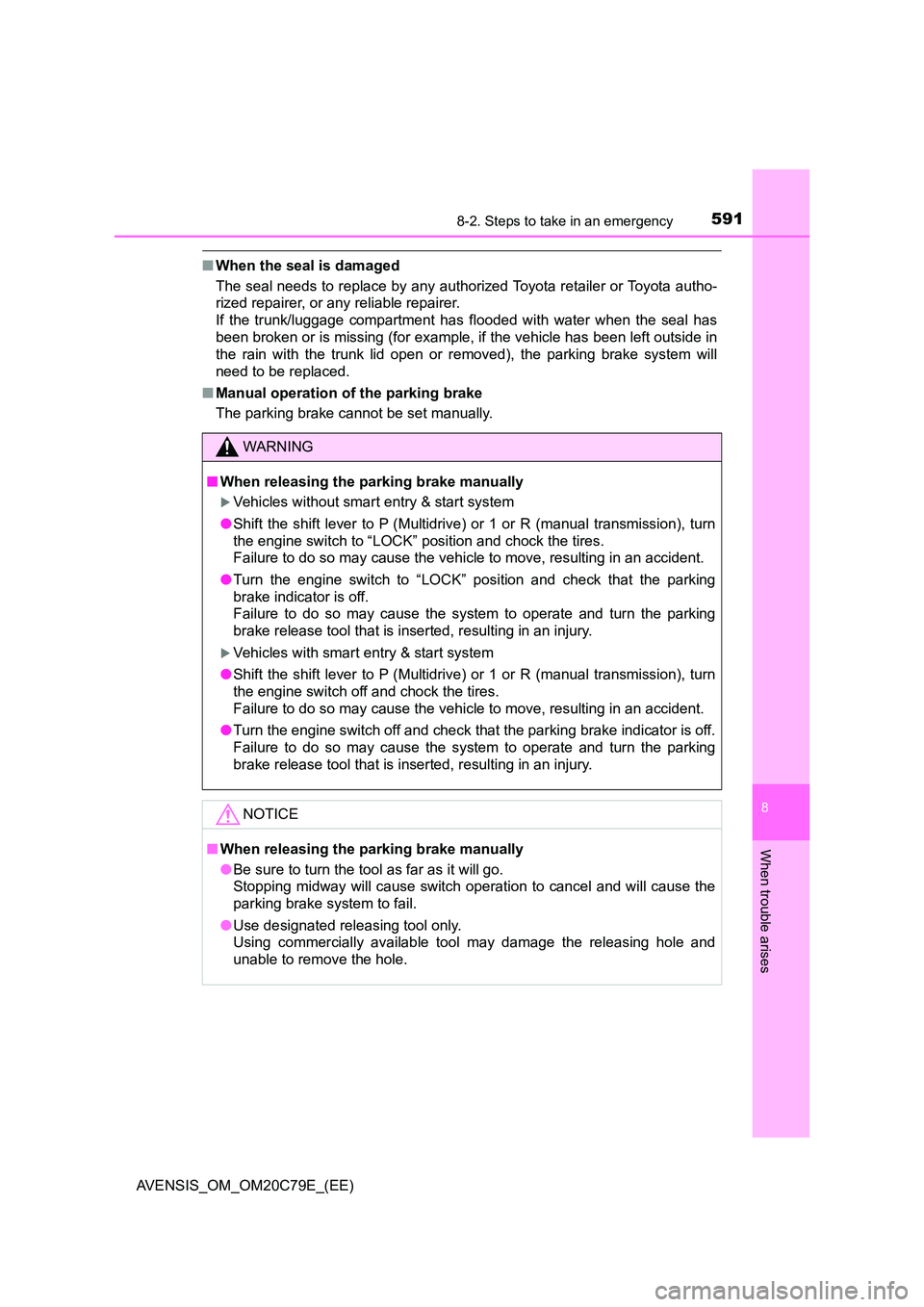
5918-2. Steps to take in an emergency
AVENSIS_OM_OM20C79E_(EE)
8
When trouble arises
■When the seal is damaged
The seal needs to replace by any authorized Toyota retailer or Toyota autho-
rized repairer, or any reliable repairer.
If the trunk/luggage compartment has flooded with water when the seal has
been broken or is missing (for example, if the vehicle has been left outside in
the rain with the trunk lid open or removed), the parking brake system will
need to be replaced.
■ Manual operation of the parking brake
The parking brake cannot be set manually.
WARNING
■ When releasing the parking brake manually
Vehicles without smart entry & start system
● Shift the shift lever to P (Multidrive) or 1 or R (manual transmission), turn
the engine switch to “LOCK” position and chock the tires.
Failure to do so may cause the vehicle to move, resulting in an accident.
● Turn the engine switch to “LOCK” position and check that the parking
brake indicator is off.
Failure to do so may cause the system to operate and turn the parking
brake release tool that is inserted, resulting in an injury.
Vehicles with smart entry & start system
● Shift the shift lever to P (Multidrive) or 1 or R (manual transmission), turn
the engine switch off and chock the tires.
Failure to do so may cause the vehicle to move, resulting in an accident.
● Turn the engine switch off and check that the parking brake indicator is off.
Failure to do so may cause the system to operate and turn the parking
brake release tool that is inserted, resulting in an injury.
NOTICE
■ When releasing the parking brake manually
● Be sure to turn the tool as far as it will go.
Stopping midway will cause switch operation to cancel and will cause the
parking brake system to fail.
● Use designated releasing tool only.
Using commercially available tool may damage the releasing hole and
unable to remove the hole.
Page 593 of 660
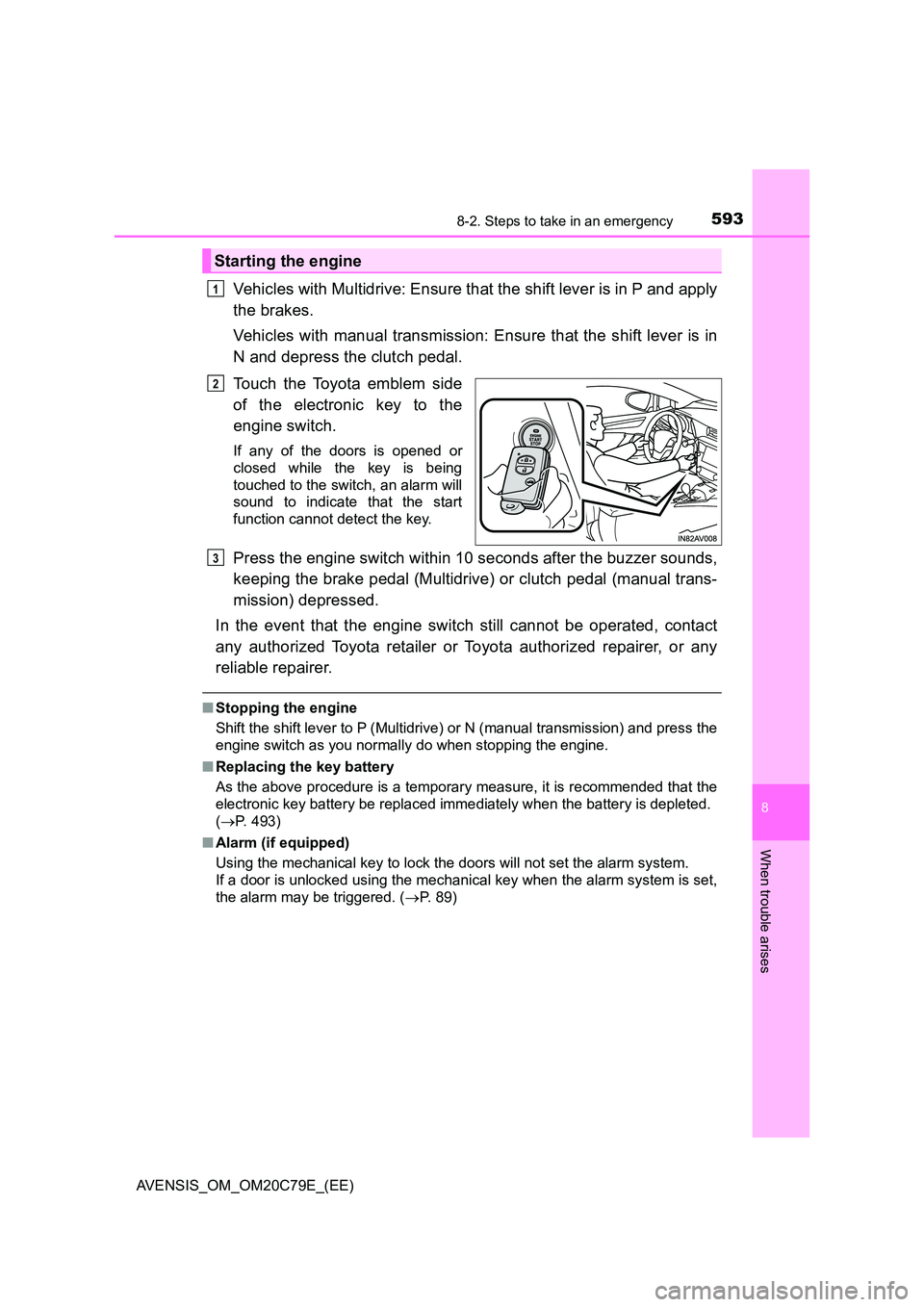
5938-2. Steps to take in an emergency
AVENSIS_OM_OM20C79E_(EE)
8
When trouble arises
Vehicles with Multidrive: Ensure that the shift lever is in P and apply
the brakes.
Vehicles with manual transmission: Ensure that the shift lever is in
N and depress the clutch pedal.
Touch the Toyota emblem side
of the electronic key to the
engine switch.
If any of the doors is opened or
closed while the key is being
touched to the switch, an alarm will
sound to indicate that the start
function cannot detect the key.
Press the engine switch within 10 seconds after the buzzer sounds,
keeping the brake pedal (Multidrive) or clutch pedal (manual trans-
mission) depressed.
In the event that the engine switch still cannot be operated, contact
any authorized Toyota retailer or Toyota authorized repairer, or any
reliable repairer.
■ Stopping the engine
Shift the shift lever to P (Multidrive) or N (manual transmission) and press the
engine switch as you normally do when stopping the engine.
■ Replacing the key battery
As the above procedure is a temporary measure, it is recommended that the
electronic key battery be replaced imm ediately when the battery is depleted.
( P. 493)
■ Alarm (if equipped)
Using the mechanical key to lock the doors will not set the alarm system.
If a door is unlocked using the mechanical key when the alarm system is set,
the alarm may be triggered. ( P. 8 9 )
Starting the engine
1
2
3
Page 594 of 660
5948-2. Steps to take in an emergency
AVENSIS_OM_OM20C79E_(EE)
■ Changing engine switch modes
Multidrive
Within 10 seconds of the buzzer sounding, release the brake pedal and press
the engine switch.
The engine does not start and modes will be changed each time the switch is
pressed. ( P. 215)
Manual transmission
Within 10 seconds of the buzzer sounding, release the clutch pedal and press
the engine switch.
The engine does not start and modes will be changed each time the switch is
pressed. ( P. 215)
Page 598 of 660
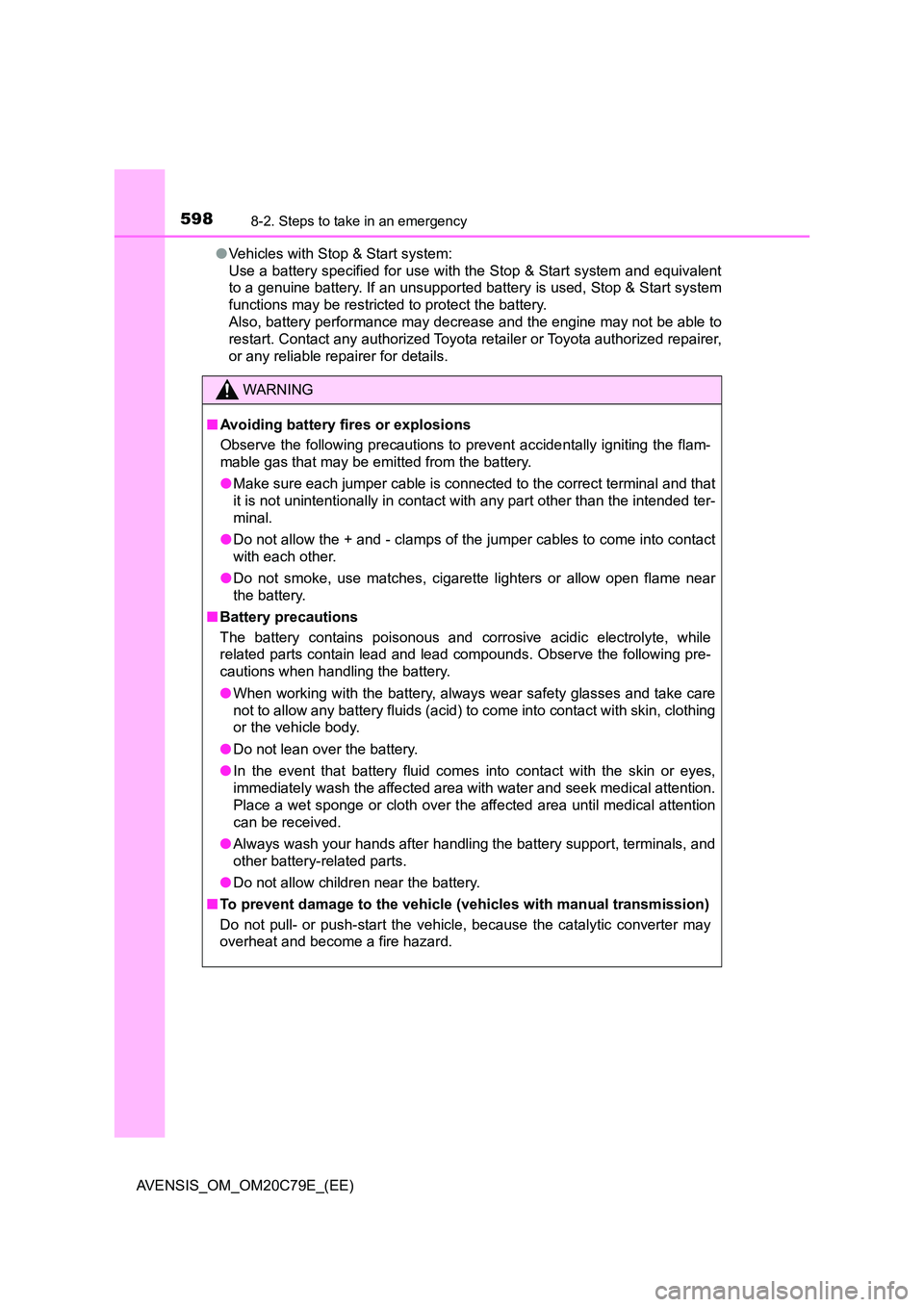
5988-2. Steps to take in an emergency
AVENSIS_OM_OM20C79E_(EE)
● Vehicles with Stop & Start system:
Use a battery specified for use with the Stop & Start system and equivalent
to a genuine battery. If an unsupported battery is used, Stop & Start system
functions may be restricted to protect the battery.
Also, battery performance may decrease and the engine may not be able to
restart. Contact any authorized Toyota retailer or Toyota authorized repairer,
or any reliable repairer for details.
WARNING
■ Avoiding battery fires or explosions
Observe the following precautions to prevent accidentally igniting the flam-
mable gas that may be emitted from the battery.
● Make sure each jumper cable is connected to the correct terminal and that
it is not unintentionally in contact with any part other than the intended ter-
minal.
● Do not allow the + and - clamps of the jumper cables to come into contact
with each other.
● Do not smoke, use matches, cigarette lighters or allow open flame near
the battery.
■ Battery precautions
The battery contains poisonous and corrosive acidic electrolyte, while
related parts contain lead and lead compounds. Observe the following pre-
cautions when handling the battery.
● When working with the battery, always wear safety glasses and take care
not to allow any battery fluids (acid) to come into contact with skin, clothing
or the vehicle body.
● Do not lean over the battery.
● In the event that battery fluid comes into contact with the skin or eyes,
immediately wash the affected area with water and seek medical attention.
Place a wet sponge or cloth over the affected area until medical attention
can be received.
● Always wash your hands after handling the battery support, terminals, and
other battery-related parts.
● Do not allow children near the battery.
■ To prevent damage to the vehicle (vehicles with manual transmission)
Do not pull- or push-start the vehicle, because the catalytic converter may
overheat and become a fire hazard.
Page 603 of 660
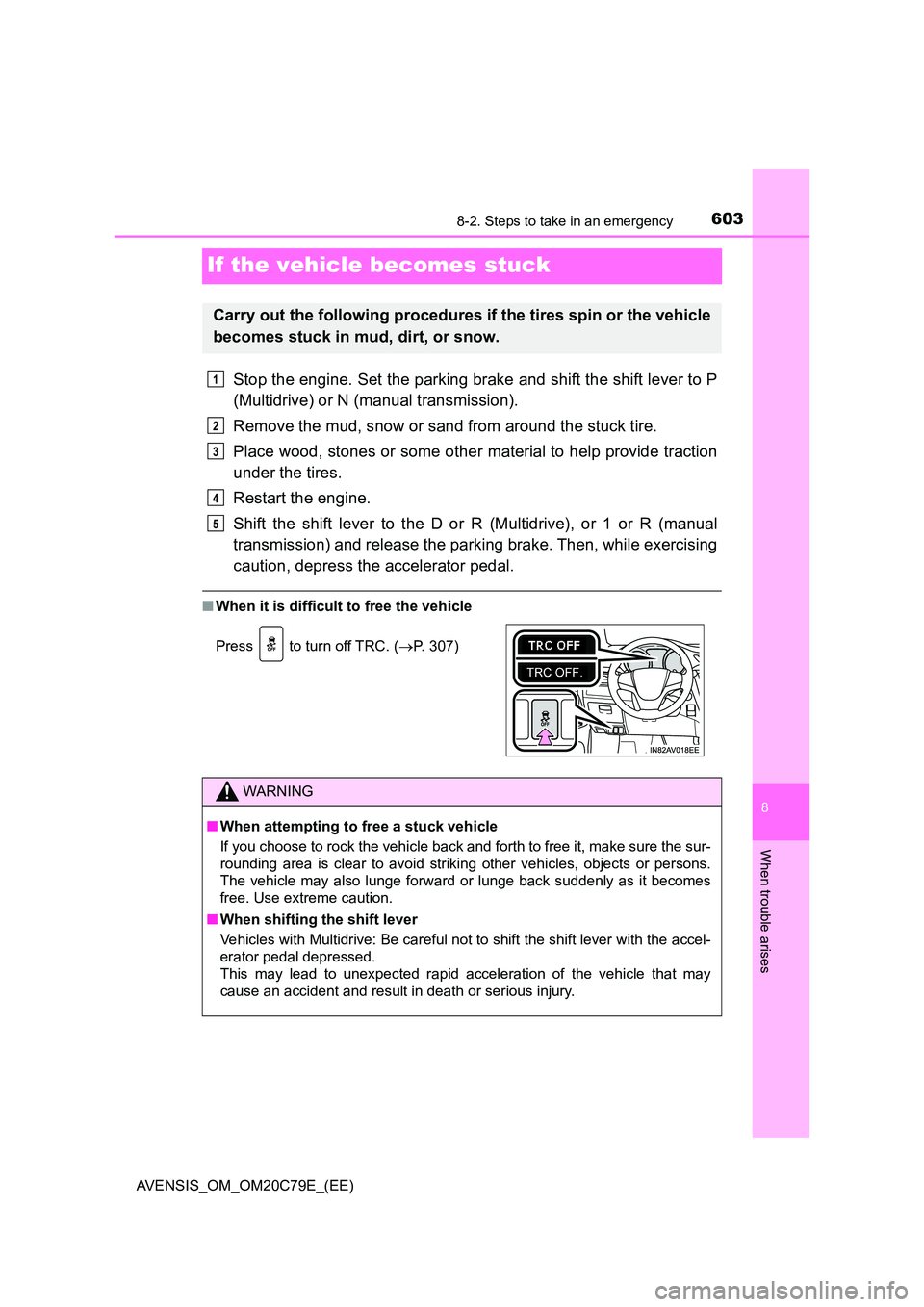
6038-2. Steps to take in an emergency
AVENSIS_OM_OM20C79E_(EE)
8
When trouble arises
If the vehicle becomes stuck
Stop the engine. Set the parking brake and shift the shift lever to P
(Multidrive) or N (manual transmission).
Remove the mud, snow or sand from around the stuck tire.
Place wood, stones or some other material to help provide traction
under the tires.
Restart the engine.
Shift the shift lever to the D or R (Multidrive), or 1 or R (manual
transmission) and release the parking brake. Then, while exercising
caution, depress the accelerator pedal.
■ When it is difficult to free the vehicle
Carry out the following procedures if the tires spin or the vehicle
becomes stuck in mud, dirt, or snow.
Press to turn off TRC. ( P. 307)
WARNING
■When attempting to free a stuck vehicle
If you choose to rock the vehicle back and forth to free it, make sure the sur-
rounding area is clear to avoid striking other vehicles, objects or persons.
The vehicle may also lunge forward or lunge back suddenly as it becomes
free. Use extreme caution.
■ When shifting the shift lever
Vehicles with Multidrive: Be careful not to shift the shift lever with the accel-
erator pedal depressed.
This may lead to unexpected rapid acceleration of the vehicle that may
cause an accident and result in death or serious injury.
1
2
3
4
5
Page 607 of 660
6079-1. Specifications
AVENSIS_OM_OM20C79E_(EE)
9
Vehicle specifications
*1: Unladen vehicles
*2: 205/60R16 tires
*3: 215/55R17 and 225/45R18 tires
*4: Vehicles with a Multidrive
*5: Vehicles with a manual transmission
Drawbar load 75 kg (165.3 lb.)
Towing capacityWith brake
1ZR-FAE engine
1400 kg (3086.5 lb.)
2ZR-FAE engine
1600 kg (3527.4 lb.)
*4
1500 kg (3306.9 lb.)*5
3ZR-FAE engine
1800 kg (3968.3 lb.)
1WW engine
1600 kg (3527.4 lb.)
2WW engine
1800 kg (3968.3 lb.)
Without brake 500 kg (1102.3 lb.)
Page 618 of 660
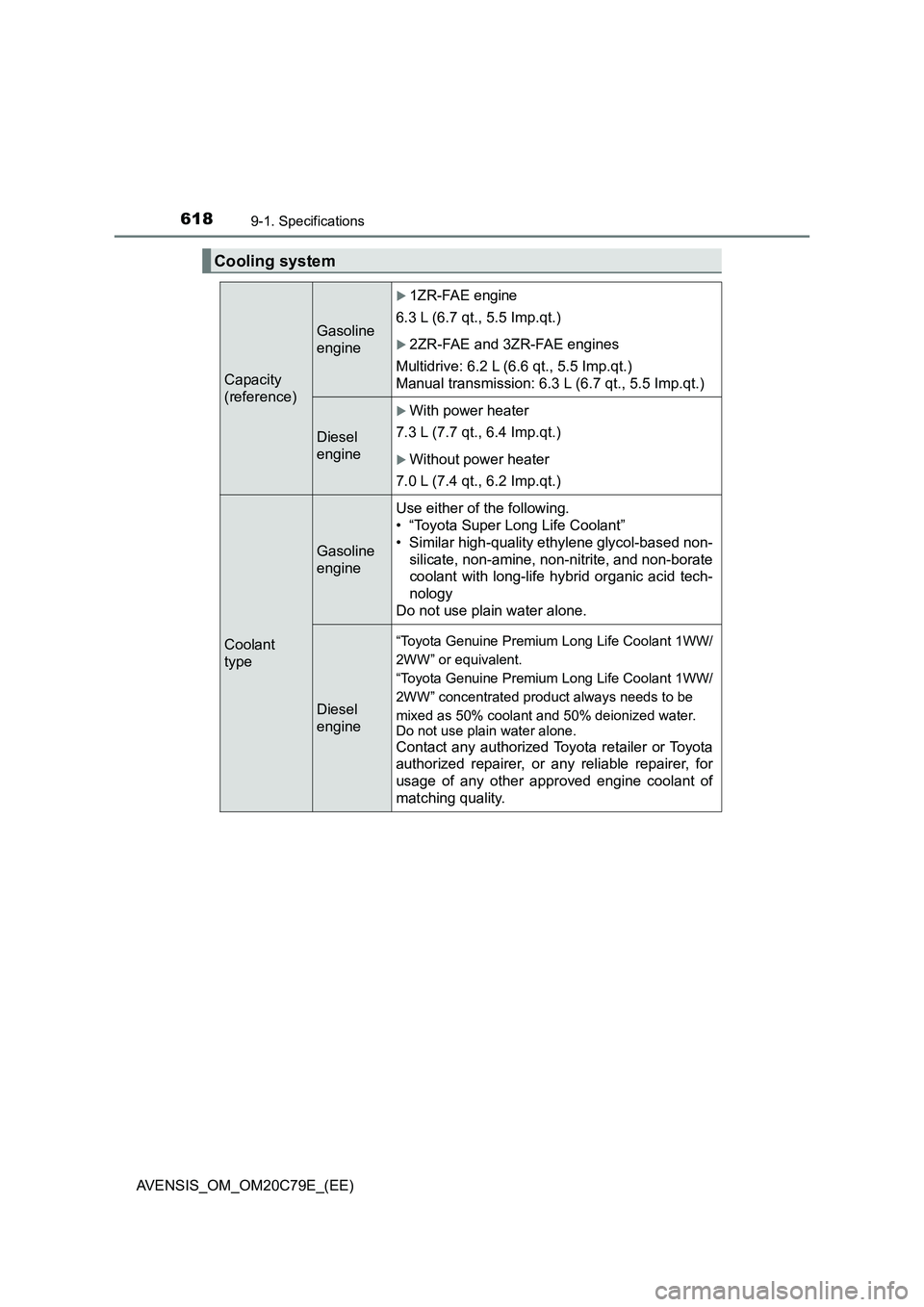
6189-1. Specifications
AVENSIS_OM_OM20C79E_(EE)
Cooling system
Capacity
(reference)
Gasoline
engine
1ZR-FAE engine
6.3 L (6.7 qt., 5.5 Imp.qt.)
2ZR-FAE and 3ZR-FAE engines
Multidrive: 6.2 L (6.6 qt., 5.5 Imp.qt.)
Manual transmission: 6.3 L (6.7 qt., 5.5 Imp.qt.)
Diesel
engine
With power heater
7.3 L (7.7 qt., 6.4 Imp.qt.)
Without power heater
7.0 L (7.4 qt., 6.2 Imp.qt.)
Coolant
type
Gasoline
engineUse either of the following.
• “Toyota Super Long Life Coolant”
• Similar high-quality ethylene glycol-based non-
silicate, non-amine, non-nitrite, and non-borate
coolant with long-life hybrid organic acid tech-
nology
Do not use plain water alone.
Diesel
engine
“Toyota Genuine Premium Long Life Coolant 1WW/
2WW” or equivalent.
“Toyota Genuine Premium Long Life Coolant 1WW/
2WW” concentrated product always needs to be
mixed as 50% coolant and 50% deionized water.
Do not use plain water alone.
Contact any authorized Toyota retailer or Toyota
authorized repairer, or any reliable repairer, for
usage of any other approved engine coolant of
matching quality.